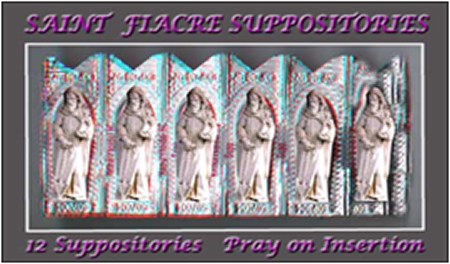[Slightly revised No. 23.3]

Capezzoli di St. Agatha, a Sicilian delicacy
The day after Halloween, in the Roman Catholic Church, is “All Saints Day.” This is a good day to pray to the patron saint for bellyaches from eating too much shitty candy you collected trick-or-treating the night before, St. Jack O’Lantern, I think, an Irish monk of the 9th Century who reputedly went pub to pub saying “drink-or-treat.” (OK, I made that last part up)
I like to think of All Saints Day as the saints marching around in Heaven singing “I want to be in that number . . .”, some holding their heads in their hands, others their balls, some of them badly scorched, other missing various limbs and appendages, all because the best way to become a saint has been to be martyred (although some have done quite a number on themselves). Of course, if you have good connections, like Pope John-Paul II, you can be canonized on the fast track without all that gory stuff.
John-Paul II might have thought that he bettered his chances for fast-track sainthood because he was quite a saint-maker himself. On October 1, 2000, he canonized a load of new saints, although many of them “made their bones” as saints hundreds of years ago. For example, a whole bunch of “martyrs of China,” both Chinese and Western missionaries, mostly beheaded, were put into service as saints. But what will J-PII, rather St. J-PII be a patron saint of. I think I should leave that to suggestions from my readers. Just click reply on the email that sent you here. I’ll publish the suggestions, with attribution, later. Meanwhile, there might be some inspiration below.
Saints are those people you see in religious paintings who have a nimbus around their heads. You know, like that little ring of golden light that Jesus usually has, that makes their heads look like little versions of Saturn. (It must really come in handy if a saint wants to read in the dark.) The Church borrowed sainthood from the cults and pantheisms of paganism to take some of the heavy lifting off of God Almighty, Jesus, the Holy Ghost and the BVM when it comes to prayer and particularly supplications. Saints handle a lot of the specifics of why people are into religion—they want or need something and they want somebody with high-level spiritual access to intercede for them. Hence, saints are usually the “patron saints” of something or other.
There are a lot of saints, some, (dozens, as in the case of the St. Marys, Marias, etc), buried in myth, many of questionable provenance, most of them patron to some group, interest, need, disease, or whatever. The Church pretty much has everything covered. For example, let’s say you are an accountant and you have just been nailed cooking the books for Enron or MCI and you want to say a prayer that your lawyer can keep your ass out of The Big House. Well, you want to pray to St Matthew the Apostle, patron saint of accountants (he also does bankers, stockbrokers, money managers and tax collectors—a little conflict of interest in that last one). But you get the idea, St. Matt knows about accountancy, so he can get your prayer on the fast track. By the way, St. Mark the Evangelist is the patron saint for lawyers, so you had better toss off a supplication to him as well. And just in case, guess what, he is also the patron saint of “imprisoned people.”
It is easy to see how some of these people got to be saints—they were heavy hitters in the New Testament. But there are plenty of saints you or I haven’t heard of. Some of these saints were into some pretty weird stuff. St. Simon Stylites, a fourth century hermetic, spent much of his life sitting on top of a sixty-foot column (I guess if he had a girl he would have put her on a pedestal—OK, OK, I won’t do that again!). There were saints who ate rotten food, buried themselves, scourged themselves, and even emasculated themselves to prove to go that they renounced this awful world.
But it was probably easier—in a relative sense—to get yourself a nimbus by being a martyr rather than a masochist. In fact, being a martyr usually was responsible for what kind of patron assignment you got when you were canonized. For instance take St, Agatha (the one from Catania, Sicily, not the others Agathas); she’s the patron saint of women with disorders of the breasts. That’s because Roman soldiers cut her breasts off when she refused to go into one of their brothels. She is often represented in religious art holding a tray on which sit her breasts, like a pair of dolce. These days Sicilian bakers make little boob-like confections called Capezzoli di St. Agatha, or Minne de Virgine on her feast day. St. Agatha is also the patroness of bell-makers because, presumably . . . .
Still, martyrdom wasn’t always an easy way to make it to sainthood. St. Stephan, the first martyr was stoned to death. I like to think of him as the patron saint of those who overdose with drugs. The Jesuits have a good many saints. When I was in high-school being taught by them they used to like to read to us from the lives of their saints when we were on a religious retreat. During meal times they would choose passages from the missionary exploits of St. Issac Jogues, and St. John de Brebeuf, Jebbie missionaries who were taken apart limb by limb and organ by organ by the Mohawks and the Huron, respectively. The graphic descriptions, one supposes, were intended as an aide-de-digestion
And that brings me back to one of the prime services of patron saints—to serve as intermediaries for our human problems. My mother always used to pray to St. Anthony when she lost or misplaced something. It took me a long time to look up which St. Anthony because there are thirty-two of them, but it is St. Anthony of Padua, who is the patron saint of “lost articles.” If Mom found, say, her house keys, she would announce that her prayer was answered; if not, well St. Anthony was still working on it, or maybe was busy because he had been assigned new responsibilities for people with lost pensions from American corporations. But it turns out that St. Anthony of Padua has a lot of responsibilities. He is (are you ready for this?) patron saint: against shipwrecks, against starvation, American Indians; amputees; animals, asses [yes, Republicans have a patron saint]; barrenness; boatmen; Brazil; Diocese of Beaum,onmt, Texas; domestic animals; elderly people; expectant mothers; faith the Blessed Sacrament; Ferrazzano, Italy; fishermen; harvests, horses; Lisbon. Portugal; lost articles; lower animals; mail (Mail?); mariners; Diocese of Mashbate, Philippines; oppressed people; Padua, Italy; paupers; poor people; Portugal; shipwrecks; starving people; sterility; swineherds; Tigua Indians; travel hostesses; travelers; watermen. Excuse me, but—Jesus! That’s a load of work for one saint! Why not off-load some of this onto one of those other St. Anthony’s, like St. Anthony Dich Nguyen of Vietnam, who was beheaded in 1838, and hasn’t been assigned any patronage work since. At least give him patron saint of American lost wars.
As one can see, saints have a lot to do, so I won’t be any more tedious and list their manifold duties. I’ll just close with a reference to St. Fiacre. He was an Irish monk who died in 670 AD. Turns out he is the patron saint of cab drivers, but the connection is a gratuitous one. There was a Hotel de St. Fiacre in Paris with a taxi stand in front. People took to calling the cabs “fiacres.” Simple as that. But since cab drivers spend a lot of time sitting in the cabs while waiting or driving, they may be prone to an occupational malady. Pas problem; St. Fiacre is also the patron saint of hemorrhoids.

©2005, UrbisMedia
___________________________________
©2005, 2014, James A. Clapp (UrbisMedia Ltd. Pub. 11.1.2014)
